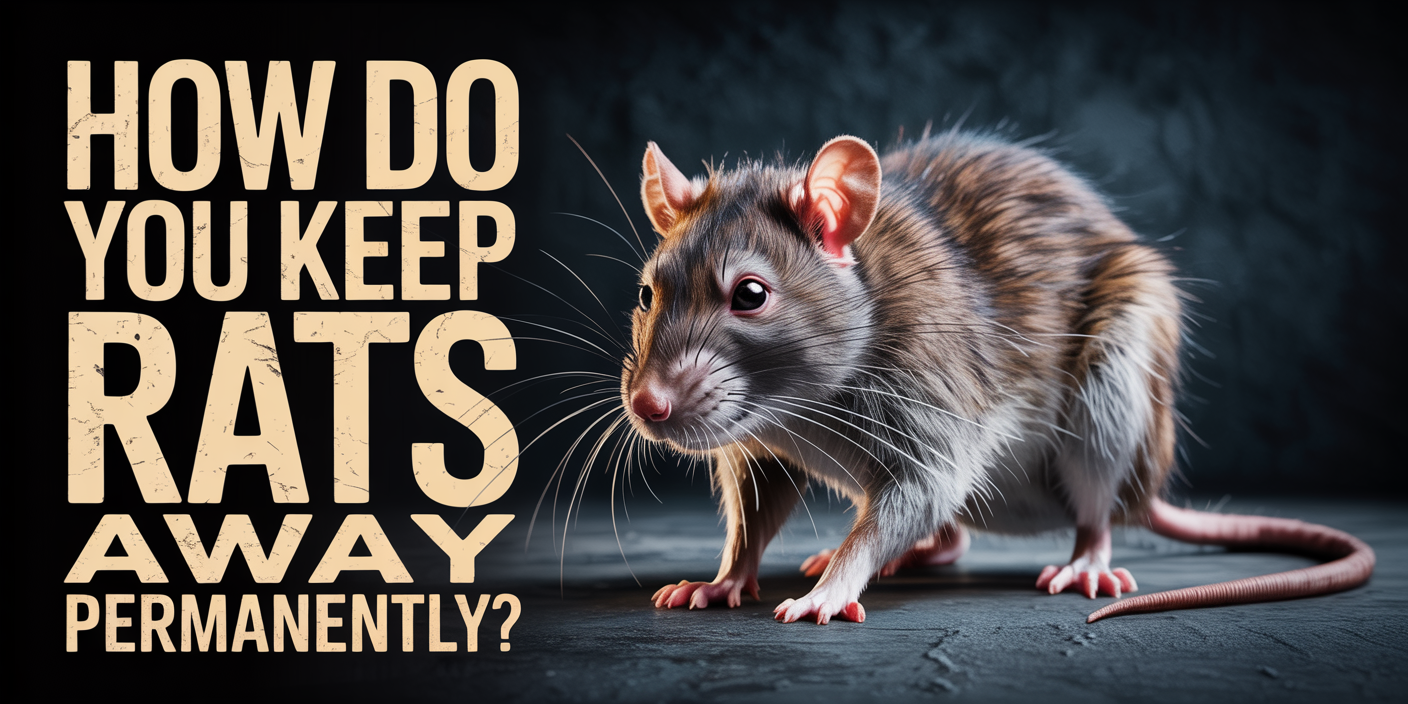“The key to keeping rats away permanently is sealing every entry point, eliminating food and water sources, and sticking to year-round prevention—no shortcuts.”
Rats are more than just an occasional nuisance in Dallas—they’re persistent, clever, and notoriously tough to get rid of for good. With the city’s mix of historic neighborhoods, thriving restaurants, and warm Texas weather, it’s no surprise that rats find plenty of reasons to stick around. If you’ve ever dealt with a late-night scurry in the attic or spotted gnaw marks on your baseboards, you know how quickly a minor rat problem can spiral into a full-blown headache.
The truth is, quick fixes and store-bought traps rarely solve the root of the issue, especially in a city like Dallas where rats can sneak in through the tiniest gaps and make themselves right at home. That’s why permanent rat control calls for a strategic, all-in approach—one that focuses on prevention, exclusion, and expert help from pros like AAAC Wildlife Removal. In this guide, you’ll learn why rats are drawn to Dallas homes, what steps actually keep them away for good, and how you can finally reclaim your space without the constant worry of unwelcome guests.
Learn more: What do professionals use for rodent control?
Why Dallas Properties Are Prone to Rat Problems
Dallas offers just about everything a rat could ever want—plenty of shelter, food, and cozy hiding spots thanks to the city’s unique blend of old and new neighborhoods. The local climate, with its mild winters and hot summers, allows rats to stay active and breed all year long. Add in the steady expansion of both residential and commercial developments, and you’ve got a recipe for regular rodent encounters.
Certain areas of Dallas, especially those near creeks, rivers, or older infrastructure, are especially susceptible to rat issues. Aging buildings often have hidden cracks and gaps that provide easy entry points, while dense urban landscaping gives rats lots of places to hide. No matter where you live in the Metroplex, understanding these local factors is key to tackling rat problems head-on and keeping them out for good.
Signs of a Rat Infestation in Dallas
1. Droppings and Gnaw Marks
One of the first signs many Dallas homeowners notice is the sudden appearance of small, dark droppings along walls, inside cabinets, or near food storage spots. These droppings can pile up quickly, especially in kitchens or pantries where rats are searching for an easy meal. If you see these scattered in places that should be clean, it’s a strong signal rats are moving in and out regularly.
Gnaw marks are another unmistakable clue. Rats in Dallas are notorious for chewing through just about anything—wood, plastic, and even electrical wiring. Fresh bite marks on furniture legs, boxes, or around vents show where they’re squeezing in and causing hidden damage. Spotting these early can save you from bigger problems down the line, like electrical shorts or structural repairs.
2. Noises in Walls and Attics
Hearing odd noises in your Dallas home, especially at night, is a classic sign that rats have moved in. Scratching, squeaking, or the faint sound of scurrying often means rats are nesting inside your walls or attic. This is particularly common in older houses around Dallas with lots of access points and hidden nooks.
These nighttime sounds might start off faint but can quickly get louder as the infestation grows. If you find yourself waking up to new bumps or rustles overhead, don’t ignore it. Investigating these noises quickly helps you spot the problem before rats start causing major damage to insulation, wiring, or stored belongings.
3. Greasy Tracks and Nesting Materials
Rats rarely travel alone, and over time, they create visible “highways” along walls and floors. The oils from their fur leave behind greasy smudge marks—especially noticeable on light-colored surfaces or tight pathways. Dallas homeowners may spot these streaks leading to attics, crawlspaces, or even outdoor sheds, showing exactly where rats are sneaking around.
In addition to tracks, rats are expert nest-builders. You might stumble across shredded insulation, paper, or fabric in hidden corners or storage boxes. These makeshift nests are often tucked away in less-visited areas like garages or the back of closets. Spotting these materials is a sure sign rats are not just passing through—they’re settling in for the long haul.
4. Strong, Unpleasant Odors
A lingering, musky smell in your Dallas home is often a sign that rats have taken up residence and are not planning to leave anytime soon. This odor, which many describe as stale or “earthy,” usually comes from a combination of rat urine, droppings, and nesting activity. It’s most noticeable in closed-off spaces like attics, storage rooms, or under sinks.
If you start picking up on this unpleasant scent—especially if it’s getting stronger—it’s a good idea to check for other signs of infestation. The smell can also attract even more pests, making the problem worse. Tackling odors early can save you from having to deal with more serious sanitation or health issues later.
5. Daytime Sightings
Seeing a rat during the day in Dallas isn’t just bad luck—it usually means the infestation is already pretty severe. Rats are naturally nocturnal and prefer to stay hidden, so daytime activity signals that their population has outgrown the usual hiding spots. This is especially common around kitchens, garages, or outdoor pet areas where food and shelter are easy to find.
Don’t shrug off a daytime sighting as a one-time event. It’s a warning that rats are becoming bold and desperate, and that your property needs immediate attention. Taking action now can keep a minor nuisance from becoming a full-blown infestation that’s harder and costlier to control.
Proven Strategies for Permanent Rat Prevention
Sealing Entry Points
The most critical step in keeping rats out for good is sealing up every gap, crack, or hole that gives them access to your home. Dallas homes often have hidden entry points in the foundation, attic vents, rooflines, and even where utility lines enter the house. Professional-grade materials like steel mesh, metal flashing, and heavy-duty sealants provide a long-lasting barrier that rats can’t chew through.
By conducting a thorough inspection, you can catch entry points that many DIYers overlook—think gaps under doors, loose siding, or cracks around windows. Once these areas are properly sealed, you cut off the easy routes rats use to get inside. This method is far more effective than relying on traps alone, since it targets the root of the problem.
Proper Food and Waste Management
Rats thrive in places where food and waste are easy to access, making Dallas kitchens, pantries, and outdoor trash bins a constant target. Securing all food in airtight containers, promptly cleaning up crumbs, and regularly taking out the garbage will make your property less appealing to rats. Compost piles and pet food left outside are also prime targets, so keeping these secured is essential.
For outdoor waste, use bins with tight-fitting lids and avoid overfilling them, since rats can squeeze through surprisingly small openings. These simple habits disrupt a rat’s food supply and encourage them to search elsewhere. Effective food and waste management works hand-in-hand with exclusion techniques to deliver lasting results.
Yard and Property Maintenance
Overgrown shrubs, dense ground cover, and cluttered yards give rats perfect hiding and nesting spots. In Dallas, where yards can quickly become dense during the growing season, trimming bushes, mowing regularly, and removing debris from around the house can make a big difference. Clearing woodpiles, fallen fruit, and unused materials takes away the places rats love to hide and breed.
Fencing and gravel borders can also discourage rats from burrowing near your foundation or getting into crawlspaces. Proactive yard maintenance not only improves curb appeal but also cuts down on potential rat problems. Staying on top of yard work is a simple way to make your home less inviting for these determined pests.
Moisture Control
Rats need water as much as they need food, and Dallas’s hot, humid climate can make standing water a regular issue. Leaky pipes, clogged gutters, and dripping HVAC units are all common water sources that rats will exploit. Fixing leaks, improving drainage, and making sure gutters are clear of debris go a long way in keeping your property dry.
Indoor moisture, such as in bathrooms, basements, or laundry rooms, should also be addressed with dehumidifiers or proper ventilation. By eliminating access to water, you remove a key factor that draws rats to your property and support the other prevention strategies for maximum effectiveness.
Why DIY Methods Usually Fall Short
Most DIY rat control products promise quick results, but they rarely address the core problem: rats are crafty, persistent, and can squeeze through openings as small as a quarter. Store-bought traps might catch a few, but unless every entry point is sealed and all attractants are removed, new rats will quickly take their place. In Dallas, where old buildings and warm weather create year-round rodent pressure, partial fixes just won’t cut it.
DIY repellents, poisons, and gadgets often provide temporary relief at best and can be risky if pets or children are nearby. Over time, rats can learn to avoid traps and ignore weak deterrents, making infestations even harder to control. Only a comprehensive, long-term strategy—like the one offered by AAAC Wildlife Removal—can truly break the cycle and keep rats away for good.
How AAAC Wildlife Removal Achieves Lasting Results
AAAC Wildlife Removal goes beyond quick fixes by starting with a detailed inspection of your Dallas property. Their team pinpoints every access point, tracks down active nests, and identifies what’s drawing rats to your home in the first place. This thorough approach means nothing gets overlooked, from attic vents to the tiniest cracks in your foundation.
Once problem areas are identified, AAAC uses professional-grade materials and exclusion techniques that have been proven to stand up to Texas’s climate and persistent rodent activity. Their specialists seal entry points, remove existing rats using humane methods, and offer long-term prevention plans tailored for Dallas homes. With follow-up support and a commitment to customer satisfaction, AAAC Wildlife Removal ensures rats stay gone—giving you lasting peace of mind and a safer, healthier property.
Conclusion
Permanently keeping rats away from your Dallas property isn’t about quick fixes—it’s about smart, consistent prevention and the right local expertise. From sealing every possible entry point to managing food, waste, and moisture, true peace of mind comes from covering all the bases and staying proactive year-round. Taking shortcuts or relying on store-bought solutions rarely solves the problem for good, especially in a city where rats are always searching for their next home.
When you’re ready to say goodbye to rodents for good, teaming up with AAAC Wildlife Removal means getting a proven process that delivers real, lasting results. With their local knowledge, advanced tools, and dedication to customer care, you can finally enjoy a rat-free home and the confidence that your investment is protected.
Ready for a Rat-Free Home? Contact AAAC Wildlife Removal Today
Don’t let rats take over your Dallas home or business—take action with the team that knows how to solve the problem for good. AAAC Wildlife Removal offers free inspections, expert advice, and permanent solutions tailored for Dallas and the surrounding areas. Their specialists use safe, humane, and proven methods to seal your property and stop rat problems before they start.
Give AAAC Wildlife Removal a call today or fill out their easy online form to schedule your inspection. Serving Dallas, Plano, Garland, Richardson, and nearby communities, AAAC is your trusted local partner for rodent removal and prevention. Get the peace of mind you deserve and keep rats out for good—let AAAC handle the rest!




